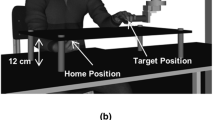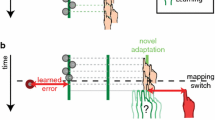Abstract
Withdrawing visual feedback after practice of a manual aiming task results in a severe decrease in aiming accuracy. This decrease in accuracy is such that participants are often less accurate than controls who are beginning practice of the task without visual feedback. These results have been interpreted as evidence that motor learning is specific to the sources of afferent information optimizing performance, because it could be processed at the exclusion of other sources of afferent information. The goal of the present study was to test this hypothesis. To reach our goal we evaluated whether online visual feedback prevented kinesthetic information to be used for: (1) eliminating movement anisotropy resulting from difference in limb inertia when aiming in different directions and (2) creating an internal model of limb mechanics. Participants practiced a manual aiming task with or without visual feedback and with knowledge of results. After this acquisition phase, participants performed two transfer tests. The first transfer test was performed without visual feedback and/or knowledge of results. The second transfer test was similar to the first one but participants initiated their movements from a different starting base. The results showed strong specificity effects in that withdrawing visual feedback resulted in large pointing bias and variability. However, the results of the two transfer tests showed that the processing of visual feedback did not prevent the processing of kinesthetic information used to eliminate movement anisotropy or to create an internal model of limb mechanics. Rather, specificity of practice effects resulted from participants using the same motor plan in transfer as they did in acquisition even though they had no longer access to visual feedback to modulate their movement online. These results indicate that during acquisition participants adopted different movement planning strategies depending on the source of afferent information available.






Similar content being viewed by others
Notes
Note that no such bias was observed when participants were trained to initiate their movements from different starting bases in the presence of knowledge of results (Lhuisset and Proteau 2004).
This definition of movement initiation differed from that used during data collection. In addition to the normal impact of the filtering procedure on the time scale, it will result in apparently longer movement times in comparison to the movement time bandwidth accepted during data collection.
References
Bédard P, Proteau L (2005) Movement planning of video and of manual aiming movements. Spat Vis 18:275–296
Charvin M, Proteau L (1996) Developmental differences in the processing of afferent information for motor control. Dev Neuropsychol 2:347–387
Chicoine A, Lassonde M, Proteau L (1992) Developmental aspects of sensorimotor integration. Dev Neuropsychol 8:381–394
Desmurget M, Grafton S (2000) Forward modeling allows feedback control for fast reaching movements. Trends Cogn Sci 4:423–431
Elliott D, Allard F (1985) The utilization of visual feedback information during rapid pointing movements. Q J Exp Psychol 37:407–425
Elliott D, Calvert R (1990) The influence of uncertainty and premovement visual information on manual aiming. Can J Exp Psychol 44:501–511
Elliott D, Carson RG, Goodman D, Chua R (1991) Discrete vs. continuous visual control of manual aiming movements. Hum Mov Sci 10:393–418
Fitts PM (1954) The information capacity of the human motor system in controlling the amplitude of movement. J Exp Psychol 47:381–391
Ghilardi MF, Gordon J, Ghez C (1995a) Deafferented subjects do not compensate for workspace anisotropies of limb movements. Electroencephalogr Clin Neurophysiol 95:73P–73P (71)
Ghilardi MF, Gordon J, Ghez C (1995b) Learning a visuomotor transformation in a local area of work space produces directional biases in other areas. J Neurophysiol 73:2535–2539
Gordon J, Ghilardi MF, Cooper SE, Ghez C (1994) Accuracy of planar reaching movements. Exp Brain Res 99:112–130
Hansen S, Glazebrook CM, Anson JG, Weeks DJ, Elliott D (2006) The influence of advance information about target location and visual feedback on movement planning and execution. Can J Exp Psychol 60:200–208
Harris CM, Wolpert DM (1998) Signal-dependent noise determines motor planning. Nature 394:780–784
Khan MA, Franks IM (2003) Online versus offline processing of visual feedback in the production of component submovements. J Mot Behav 35:285–295
Khan MA, Franks IM, Goodman D (1998) The effect of practice on the control of rapid aiming movements: evidence for an interdependency between programming and feedback processing. Q J Exp Psychol 51:425–443
Khan MA, Franks IM, Elliott D, Lawrence GP, Chua R, Bernier PM, Hansen S, Weeks DJ (2006) Inferring online and offline processing of visual feedback in target-directed movements from kinematic data. Neurosci Biobehav Rev 30:1106–1121
Lhuisset L, Proteau L (2004) Planning and control of straight-ahead and angled planar movements in adults and young children. Can J Exp Psychol 58:245–258
Meyer DE, Abrams RA, Kornblum S, Wright CE, Smith JE (1988) Optimality in human motor performance: ideal control of rapid aimed movements. Psychol Rev 95:340–370
Novak K, Miller L, Houk J (2002) The use of overlapping submovements in the control of rapid hand movements. Exp Brain Res 144:351–364
Novak K, Miller L, Houk J (2003) Features of motor performance that drive adaptation in rapid hand movements. Exp Brain Res 148:388–400
Proteau L (1992) On the specificity of learning and the role of visual information for movement control. In: Proteau L, Elliott D (eds) Vision and motor control, vol 85. North Holland, Amsterdam, pp 67–103
Proteau L (2005) Visual afferent information dominates other sources of afferent information during mixed practice of a video-aiming task. Exp Brain Res 161:441–456
Proteau L, Carnahan H (2001) What causes specificity of practice in a manual aiming movement: vision dominance or transformation errors? J Mot Behav 33:226
Proteau L, Cournoyer J (1990) Vision of the stylus in a manual aiming task: the effect of practice. Q J Exp Psychol 42A:811–828
Proteau L, Marteniuk RG, Girouard Y, Dugas C (1987) On the type of information used to control and learn an aiming movement after moderate and extensive training. Hum Mov Sci 6:181–199
Proteau L, Al Roujoula A, Messier J (2007) Online control of video-aiming movements: fast and efficient corrections of undetected experimentally-induced errors. Unpublished data
Robin C, Toussaint L, Blandin Y, Proteau L (2005) Specificity of learning in a video-aiming task: modifying the salience of dynamic visual cues. J Mot Behav 37:367–376
Rossetti Y, Desmurget M, Prablanc C (1995) Vectorial coding of movement: vision, proprioception, or both? J Neurophysiol 74:457–463
Soucy MC, Proteau L (2001) Development of multiple movement representations with practice: specificity versus flexibility. J Mot Behav 33:243–254
Tremblay L, Proteau L (1998) Specificity of practice: the case of powerlifting. Res Q Exerc Sport 69:284–289
Virji-Babul N, Sainburg RL, Huang H, Ghez C (1997) Rate of learning novel limb dynamics depends on the nature of feedback signals. Soc Neurosci 85
Author information
Authors and Affiliations
Corresponding author
Rights and permissions
About this article
Cite this article
Mackrous, I., Proteau, L. Specificity of practice results from differences in movement planning strategies. Exp Brain Res 183, 181–193 (2007). https://doi.org/10.1007/s00221-007-1031-z
Received:
Accepted:
Published:
Issue Date:
DOI: https://doi.org/10.1007/s00221-007-1031-z




